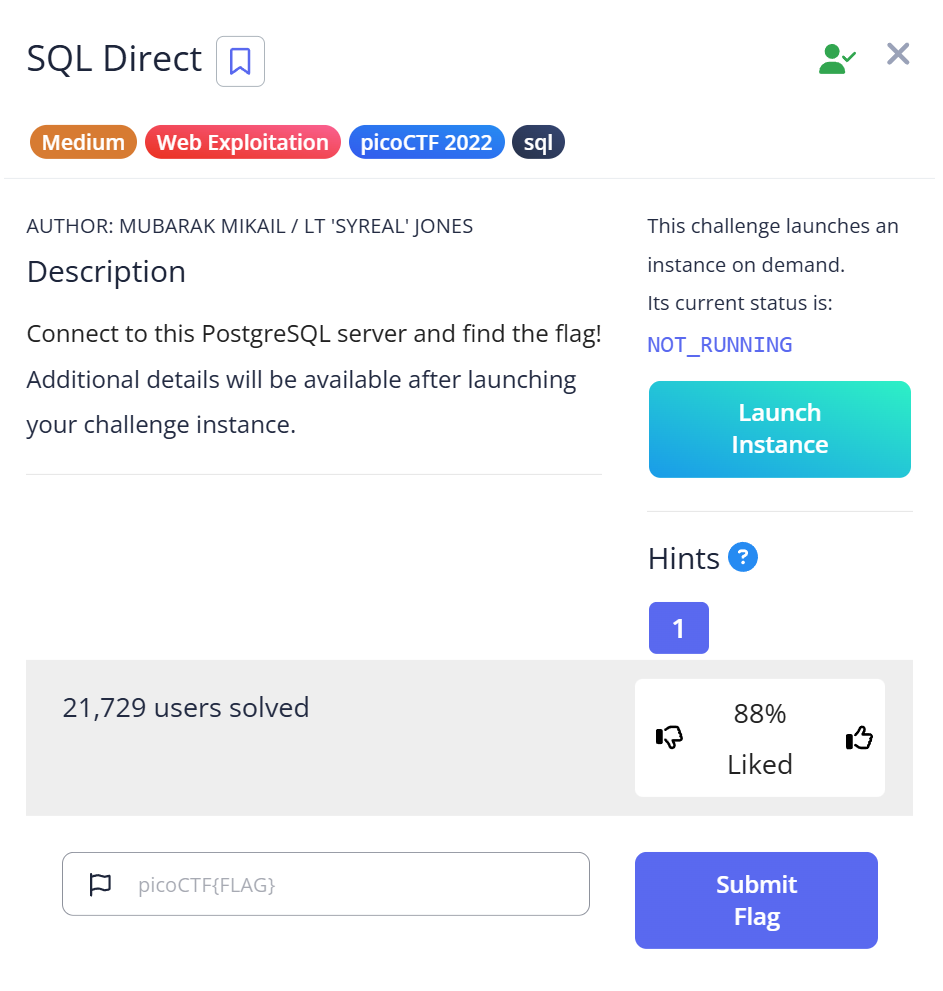Description
Connect to this PostgreSQL server and find the flag!
Additional details will be available after launching your challenge instance.
📝 Challenge Overview
In SQL Direct (AUTHOR: MUBARAK MIKAIL / LT “SYREAL” JONES) you are asked to connect to a remote PostgreSQL server and find the flag stored in a database table. This is a beginner‑friendly exercise in using psql (the PostgreSQL client), running simple SQL queries, and reading query output to locate the flag.
🔧 Step 1: Install PostgreSQL client (if needed)
- On an Ubuntu/Debian machine, install the server and client tools (server install not strictly required for connecting to a remote host, but
postgresql-clientis).
sudo apt install postgresql postgresql-contrib sudo apt-get install postgresql-client
📝 Explanation: Installing postgresql-client gives you psql, the command‑line tool used to connect to and query PostgreSQL servers. The server package is optional for local DB work.
🔗 Step 2: Connect to the remote database with psql
- Use
psqlto connect to the remote host (replace host, port, user, db as required):
psql -h saturn.picoctf.net -p 62349 -U postgres pico
- Provide the password when prompted. Example connection banner you might see:
psql (12.12 (Ubuntu ...), server 14.2 ...) WARNING: psql major version 12, server major version 14. Type "help" for help.
📝 Explanation: -h specifies host, -p port, -U user, and the last argument is the database name. psql will prompt for the user’s password. The version warning is informational — psql can still work across minor version differences.
📋 Step 3: Inspect tables and query for flags
- List available tables:
select * from pg_tables;
- If you suspect a table named
flags(common in CTFs), query it:
select * from flags;
- Example result from the remote server:
id | firstname | lastname | address
----+-----------+-----------+----------------------------------------
1 | Luke | Skywalker | picoCTF{L3arN_S0m3_5qL_t0d4Y_31fd14c0}
2 | Leia | Organa | Alderaan
3 | Han | Solo | Corellia
(3 rows)
📝 Explanation: SELECT * FROM flags; fetches all rows from the flags table. The flag was stored in the address column of row id = 1. Many CTF challenges hide flags in obvious tables named flag, flags, or secret.
🏁 Capture the Flag
🎉 The flag found in the flags table is:picoCTF{L3arN_S0m3_5qL_t0d4Y_31fd14c0}
Summary
| Step | Command / Action | Purpose | Key Result |
|---|---|---|---|
| 1 | sudo apt install postgresql postgresql-contrib / sudo apt-get install postgresql-client | Install PostgreSQL tools and psql client | psql available locally |
| 2 | psql -h saturn.picoctf.net -p 62349 -U postgres pico | Connect to remote PostgreSQL database | Connected to remote DB (prompt for password) |
| 3 | select * from pg_tables; then select * from flags; | Discover tables and read the flags table | Retrieved picoCTF{...} from address column |
💡 Beginner Tips
- 🔎 Try
\dtinpsqlto quickly list tables (\dtis a meta‑command). - 🧾 Use
\cto switch databases and\qto quitpsql. - 🛡️ Avoid running destructive SQL (like
DROP TABLE) on remote CTF hosts — read only unless instructed otherwise. - 🗂 Columns sometimes hold flags (e.g.,
note,comment,address) — inspect all columns in small tables.
🎓 What you learn (takeaways)
- How to install and use
psqlto connect to remote PostgreSQL instances. - Basic SQL querying (
SELECT * FROM table) is often enough to find flags in beginner CTFs. - Table and column names are clues —
flags,secret,notesare common places to look. psqlmeta‑commands (\dt,\d tablename) accelerate exploration.
⚡ Short explanations for commands / techniques used
sudo apt install postgresql postgresql-contrib- What: Installs PostgreSQL server and extra utilities on Debian/Ubuntu.
- Why: Useful if you want to run a local PostgreSQL server in addition to the client.
sudo apt-get install postgresql-client- What: Installs only the client tools (includes
psql). - Why: Enough to connect to and query remote PostgreSQL databases without running a local server.
- What: Installs only the client tools (includes
psql -h <host> -p <port> -U <user> <database>- What: Connects to a PostgreSQL server using
psql. - Why: Standard way to access a remote PostgreSQL database from the terminal.
- What: Connects to a PostgreSQL server using
select * from pg_tables;- What: Queries the system view listing tables visible to the current user.
- Why: Helps discover which tables exist in the database.
select * from flags;- What: Selects all rows and columns from the
flagstable. - Why: Direct way to retrieve stored flags when the table name is known or suspected.
- What: Selects all rows and columns from the
psqlmeta‑commands (\dt,\d table,\q)- What:
\dtlists tables,\d tabledescribes a table’s columns,\qquits. - Why: Faster, interactive navigation inside
psql.
- What:
